
Manual Transmission/automatic transmission? What is best choice for you!
The use of a manual or automatic transmission is a common question among drivers. When it comes to this topic, it appears that you are either on one side or the other, with manual users preferring the authentic driving experience and automatic users preferring the relaxed, easier drive.
However, if you are undecided and unable to make a decision, the advantages and disadvantages are listed below to help you decide which type of transmission is best for you and how to maintain car service in Reading.
What is the difference between an automatic transmission and a manual transmission?
The difference between a manual and an automatic car is that the driver of a manual car must change gears. The driver of a manual transmission vehicle must depress the clutch pedal and manually shift through all gears using the gear stick.
Automatic vehicles are much simpler to operate because all you have to do is select whether you want to drive, reverse, be in neutral, or park, and the vehicle will do the rest. A clutch is absent in an automatic vehicle, and the gear stick's options are limited to drive, reverse, neutral, and park.
Advantages of manual transmission
In the United States, manual transmission, also known as stick shift, is the original and standard equipment used in vehicles. In manual cars, a 6-speed manual transmission is common:
Control
Having complete control over the vehicle is one of the primary advantages of driving a manual. The driver chooses when and what gear to use, so on a hill start, they can go straight from 2nd to 4th gear to get the necessary power. In an automatic, this would be impossible. This could lead to better vehicle performance. The car will respond and perform better than an automatic vehicle if the driver can shift into the proper gear at the right time.
Driving a manual car is regarded as the "proper" way to operate a vehicle and provides an authentic driving experience. This is why owners of sports cars may prefer manual transmissions because they can control all of that horsepower through the gears, making the experience more enjoyable.
Cheaper
Because manual cars are less expensive to buy, repair, and insure than automatics, they are a more cost-effective option, especially for young drivers.
Disadvantages of manual transmission
Effort
Driving a manual transmission car requires significantly more effort than driving an automatic transmission car due to the clutch pedal. You may have experienced this yourself or know someone who has 'clutch foot.' What is the definition of a clutch foot? This is a painful foot from constantly pressing the clutch and locating the biting point through miles and miles of stop-and-go traffic.
More difficult to learn
Learning to drive a manual transmission car transmission is more difficult than learning to drive an automatic transmission car transmission. New drivers are bound to have the experience of stalling at the most inconvenient time and hearing the constant honking from the traffic jam that they have caused.
More difficult to control
Another disadvantage of driving a manual vehicle is that it is more difficult to control. This is especially true when climbing hills or steep inclines. Precise control is required to avoid the car rolling back, stalling, and finding the right gear to give the car enough power.
Advantages of automatic transmission
The automatic transmission works by changing gear ratios automatically as the vehicle moves. This eliminates the need for the clutch pedal and relieves the driver of the burden of manually changing gears:
Easier to drive
Unlike manual transmission vehicles, which are difficult to drive in stop-and-go traffic as well as on hills and inclines, automatic transmission vehicles are easy to drive. There is no clutch, so there is no "clutch foot," and gears change automatically, preventing stalling and rolling back on inclines.
Better mileage
It is widely assumed that manual cars get better gas mileage than automatic cars, and this was once true. Modern automatic cars outperform manuals in terms of fuel economy due to the increased use of continuously variable transmissions (CVTs), which can continuously vary gear ratios to increase fuel economy.
More inclusive
The availability of automatic cars is beneficial because it allows people who are unable to drive manual cars to do so. Motability provides automatic vehicles to disabled customers. 45 percent of their customers prefer a vehicle with an automatic or semi-automatic transmission, according to them. A manual can be driven by anyone, whereas an automatic can be difficult for some people.
The disadvantages of automatic transmission
Expensive
Because manual vehicles are so common, they are much less expensive to repair than automatics. Automobiles with automatic transmissions are also more expensive to buy new or used, as well as to insure.
Less enjoyable to drive
This is entirely subjective, but the general idea is that when you have complete control of your vehicle, as you do with a manual, driving becomes more enjoyable. A manual car is less predictable because you have more control over it, and if done correctly, you can improve the car's performance.
Restricts new drivers
If a new driver learns to drive or passes their test in an automatic, they are only qualified to drive automatics and not manuals. It is preferable to take your test in a manual vehicle so that you can later choose whether to drive a manual or an automatic transmission.
While weighing the benefits and drawbacks, one factor that can ultimately influence a decision between manual and automatic transmissions is lifestyle. Automatic vehicles are preferable for the disabled or for people who live in congested urban areas. Manual vehicles may be more suitable for long-distance driving, making the journey more enjoyable.